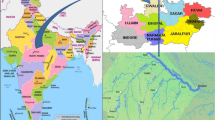Abstract
Water quality parameters like temperature, pH, total dissolved solids (TDS), total suspended solids (TSS), dissolved oxygen (DO), oil and grease, etc., are calculated from the field while parameters like biological oxygen demand (BOD) and chemical oxygen demand (COD) are interpreted through the laboratory tests. On one hand parameters like temperature, pH, DO, etc., can be accurately measured with the exceeding simplicity, whereas on the other hand calculation of BOD and COD is not only cumbersome but also inaccurate many times. A number of previous researchers have tried to use different empirical methods to predict BOD and COD but these empirical methods have their limitations due to their less versatile application. In this paper, an attempt has been made to calculate BOD and COD from simple field parameters like temperature, pH, DO, TSS, etc., using Artificial Neural Network (ANN) method. Datasets have been obtained from analysis of mine water discharge of one of the mines in Jharia coalfield, Jharkhand, India. 73 data sets were used to establish ANN architecture out of which 58 datasets were used to train the network while 15 datasets for testing the network. The results show encouraging similarity between experimental and predicted values. The RMSE values obtained for the BOD and COD are 0.114 and 0.983 %, respectively.








Similar content being viewed by others
References
ASTM D5358-93 (2009) Standard practice for sampling with a dipper or pond sampler. doi:10.1520/D5358-93R09
ASTM D6238-98 (2011) Standard test method for total oxygen demand in water. doi:10.1520/D6238-98R11
Barnes D, Forster CF, Hrudey SE (1987) Surveys in industrial wastewater treatment: manufacturing and chemical industries. Pittman Publishing Limited, London, pp 1–214
Boyd CE (1982) Water quality management for pond fish culture. Developments in aquaculture and fisheries science, vol 9. Elsevier, Amsterdam, p 318
Central Ground Water Board (2009) Ground water information booklet, (http://cgwb.gov.in/District_Profile/Jharkhand/Dhanbad.pdf)
Central Pollution Control Board (CPCB) (2012) Water quality criteria, http://www.cpcb.nic.in/Water_Quality_Criteria.php
Govindaraju RS, Rao AR (2000) Introduction in artificial neural networks in hydrology. Kluwer, Dordrecht, pp 1–7
Hopfield J (1982) Neural networks and physical systems with emergent collective computational abilities. Proc Natl Acad Sci 79:2554–2558
Jang JSR, Sun CT, Mizutani E (1997) Neuro-fuzzy and soft computing. Prentice-Hall, Englewood Cliffs
Jingsheng C, Tao Y, Ongley E (2006) Influence of high levels of total suspended solids on measurement of COD and BOD in the Yellow River. China Environ Monit Assess 116(1–3):321–334
Kunhikrishnan A, Bolan NS, Müller K, Laurenson S, Naidu R, Won-I K (2012) Chapter five—the influence of wastewater irrigation on the transformation and bioavailability of heavy metal(loid)s in soil. Adv Agron 115:215–297
Liang-qi Lei, Ci-an Song, Xiang-li Xie, Yan-hong Li, Fei Wang (2010) Acid mine drainage and heavy metal contamination in groundwater of metal sulfide mine at arid territory (BS mine, Western Australia). Trans Nonferrous Metals Soc China 20(8):1488–1493
Lindstrom HL, Abrahammson O, Johnson H (1999) An empirical model for the prediction of lake water suspended particulate matter. Ecol Model 121:185–198
Maier HR, Dandy GC (2000) Neural networks for the prediction and forecasting of water resources variables: a review of modelling issues and applications. Environ Model Softw 15(1):101–124
Mehrotra K, Chilukiri KM, Ranka S (2000) Elements of artificial neural network oxygen budgets in macrophyte impacted streams. Water Res 16:1037–1046
Metz CR (1988) Schaum’s outline of physical chemistry. McGraw-Hill, USA, p 159
Monjezi M, Amir B, Ali Yazdian V, Ahmad Reza S (2011) Prediction and controlling of flyrock in blasting operation using artificial neural network. Arabian J Geosci 4(3–4):421–425
Petit GD (1973) Effects of dissolved oxygen on survival and behavior of selected fishes of western Lake Erie. Bull Ohio Biol Surv 4:1–76
Ratnakar D, Singh VS, Hodlur GK (2008) Impact assessment of chromite mining on groundwater through simulation modeling study in Sukinda chromite mining area, Orissa, India. J Hazard Mater 160(2–3):535–547
ReVelle P, ReVelle C (1988) The environment: issues and choices for society, 3rd edn. Jones and Bartlett Publishers, Boston 749
Singh TN, Verma AK (2005) Prediction of creep characteristic of rock under varying environment. Environ Geol Springer Publ 48(4–5):559–568
Singh TN, Verma AK (2011) Comparative analysis of intelligent algorithms to correlate strength and petrographic properties of some schistose rocks. Eng Comput. doi:10.1007/s00366-011-0210-5
Singh TN, Kanchan R, Saigal K, Verma AK (2004) Prediction of P-wave velocity and anisotropic property of rock using artificial neural network technique. J Sci Ind Res 63(1):32–38
Singh TN, Singh VK, Sinha S (2006) Prediction of cadmium removal using an artificial neural network and a Neuro-Fuzzy technique. Mine Water Environ J IMWA 25:214–219
Singh TN, Verma AK, Sharma PK (2007) A Neuro-genetic approach for prediction of time dependent deformational characteristic of rock and its sensitivity analysis. Geotech Geol Eng 25:395–407
Singh AK, Sharma M, Singh MP (2008) Genesis of natural cokes: some Indian examples. Int J Coal Geol 75(1):40–48
Sreekanth PD, Sreedevi PD, Shakeel Ahmed (2011) Comparison of FFNN and ANFIS models for estimating groundwater level. Environ Earth Sci 62(6):1301–1310
Verma AK, Singh TN (2012a) Comparative study of cognitive systems for ground vibration measurements. Neural comput Appl. doi:10.1007/s00521-012-0845
Verma AK, Singh TN (2012b) A Neuro-Fuzzy approach for prediction of longitudinal wave velocity. Neural Comput Appl. doi:10.1007/s00521-012-0817-5
Wang Z, Wu Q, Zhang Y (2011) Confined groundwater pollution mechanism and vulnerability assessment in oilfields, North China. Environ Earth Sci 64(6):1547–1553
Wu X, Westerervelt JD (1991) Engineering application of neural computing: a state of art survey. USACERL Special Report No-91/22, University of Illinois, Champaign
Tchobanoglous G, Burton FL, Stensel HD (2003) Meltcalf & Eddy, Inc.'s Wastewater engineering: treatment, disposal, and reuse, 4th edn. McGraw-Hill, Inc., New York, p 181
Author information
Authors and Affiliations
Corresponding author
Rights and permissions
About this article
Cite this article
Verma, A.K., Singh, T.N. Prediction of water quality from simple field parameters. Environ Earth Sci 69, 821–829 (2013). https://doi.org/10.1007/s12665-012-1967-6
Received:
Accepted:
Published:
Issue Date:
DOI: https://doi.org/10.1007/s12665-012-1967-6




